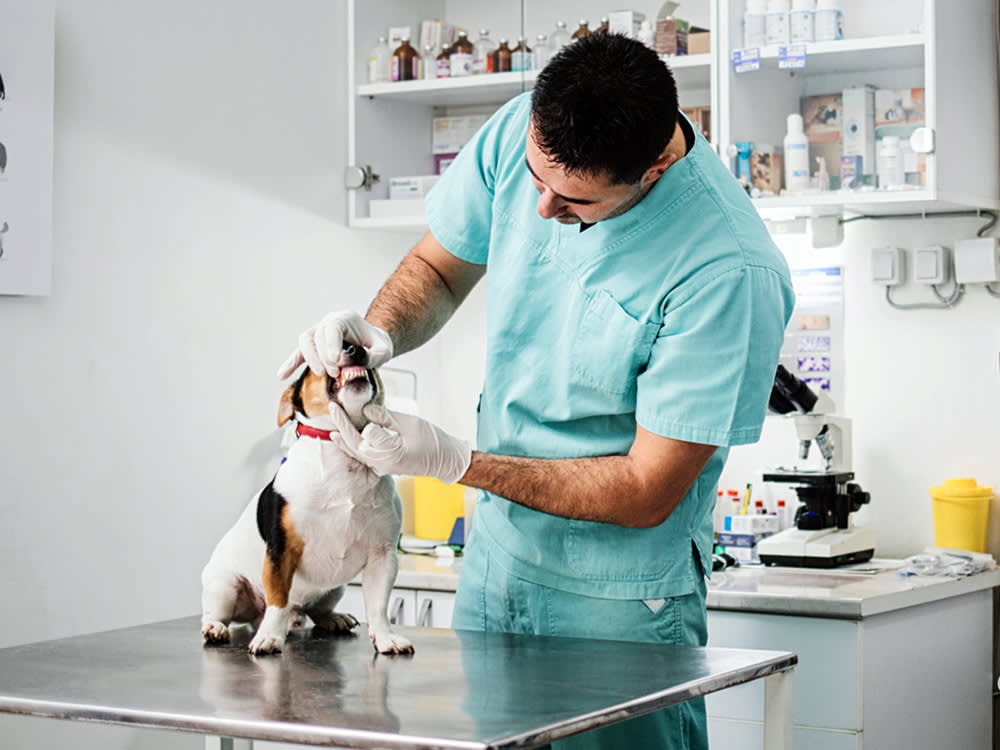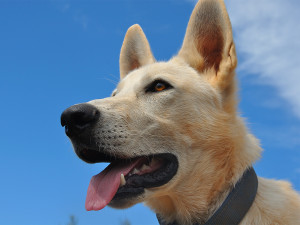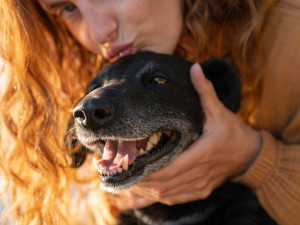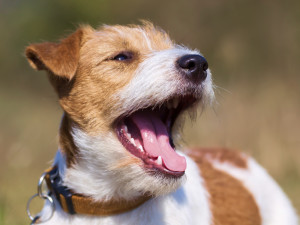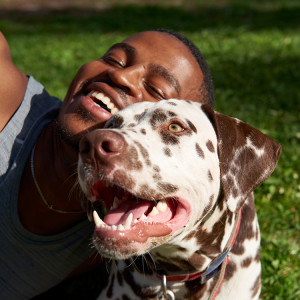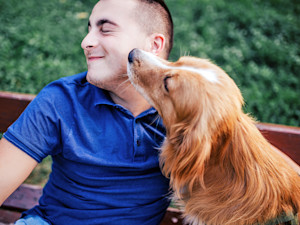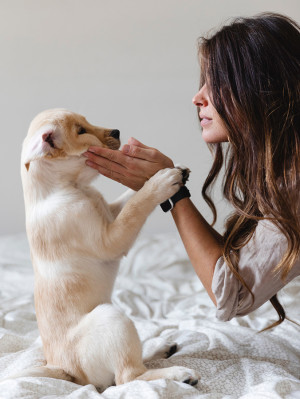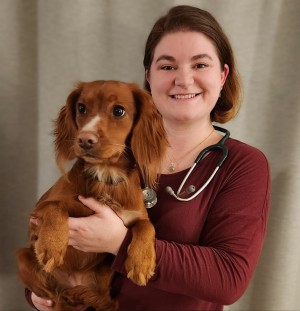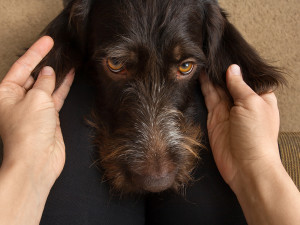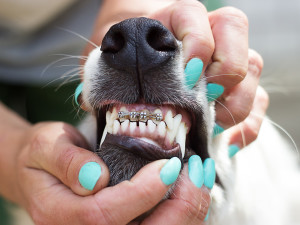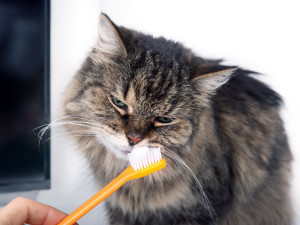Preventing, Managing & Treating Gum Disease In Dogs
Everything you need to know about the most common – and preventable disease your dog can get
Want to know which ailment you should expect in your dog the most? That’s right, gum disease.
Periodontal disease is the most common disease in dogs over three years oldopens in new tab, with a frequency reported between 80-89 perecent. Considering there’s around 13.5 million dogsopens in new tab in the UK, that‘s a lot of dogs with poorly teeth!
Sadly, periodontal disease is often caught late as many pups hide this disease from us until something else brings them to the vet and the truth comes out. Ahead, we explore what rotten dog teeth are and how we treat tooth decay in dogs here in the UK. We’ll also take a look at what type of dental care for pets we can do to help at home and treatment options at the vets.
What are rotten dog teeth?
Rotten dog teeth is a way to describe the overall appearance of periodontal disease in dogs. Periodontal disease is inflammation and infection of the tissue that surrounds your dog’s teeth and holds them in place. It is a combination of plaque building up, subsequent gingivitis and periodontal pockets (gaps around the teeth in the gum) developing. This leads to tissue and then bone getting eaten away by bacteria and infection until eventually teeth become loose and fall out. Not a nice experience! The symptoms of early periodontal disease are very hard to spot.
To help differentiate between dental issues here are some comparisons:
Early dental disease symptoms
Plaque: a slimy biofilm from bacteria in the mouth.
Tartar: hardened, mineralised plaque build up.
Gingivitis: inflammation of the gums causing pain.
Advanced dental disease (rotten teeth) symptoms
Periodontal pockets: erosion into the gum line.
Periodontal ligament damage: the ligament that holds teeth in place.
Bone erosion: leading to deep infections and even jaw fractures.
Causes of rotten teeth in dogs
When we think of tooth decay what comes to mind is the telling off we had as children about not eating too many sweets or we’ll get cavities and need fillings. This is similar in pets but not quite the same in pets; dogs rarely get cavities in their teeth like we do, instead, it’s the surrounding tissue that is affected more.
However, similar to humans, diet does have an impact on the health of a dog’s mouth. Dogs that eat a hard, kibble-based diet tend to develop fewer dental problems due to the mechanical ‘cleaning’ effect the chewing creates. And those dogs who receive more sweet treats show more dental problems due to the bacteria thriving in sweet, rich conditions.
The main cause of dental issues in dogs however, is poor oral hygiene. Teeth brushing is a given in the daily routine of humans but has only recently gained popularity in standard dog care. Other causes of rotten dog teeth comes down to genetics and underlying health conditions. For example smaller breeds of dogs with teeth sitting close together in short mouths tend to have higher risk of dental diseaseopens in new tab.
Risk factors that make dental disease more likely include things such as not brushing your dog’s teeth often, feeding them soft meals instead of kibble-based diets or feeding them sweet treats. The main risk factor for rotten teeth in dogs is lack of treatment for early stage dental disease and gingivitis which is the final reversible process before periodontal disease takes hold.
Identifying rotten teeth in dogs
Dogs tend to hide the symptoms of dental disease until pain and infection become quite severe, and so it is important to be able to recognise the early signs of the disease in order to combat it as soon as possible.
Visual inspection of the teeth is best, so try to get your dog used to examinations right from puppyhood to normalise the routine care that is necessary. Look for signs of discolouration on the teeth which can be the start of tartar build-up, or a red line along the gum which is the initial process of gingivitis. As dental issues progress, things to spot are bleeding gums and bad breath, signs of pain may be apparent when eating – perhaps they might yelp or display difficulty chewing – sometimes they can go off their food altogether. Other symptoms your dog may show include drooling, blood on chew toys or pawing at their mouth and face. Keep an eye out too for signs that an infection has created an abscess by being on the lookout for swellings over the cheeks or any discharge like pus.
Health implications of gum disease
Rotting teeth and infections within the gum are not only painful and cause horrendous breath, but it also puts your pet at risk of further issues and serious health problems. In the mouth itself, once the disease progresses, there can be damage to the ligament, tissues and bone holding the teeth in place which could cause them to become loose and fall out. There are many nerves within the jaw and into the teeth so this process is painful and causes difficulty chewing. Sometimes the jaw can become so weakened that fractures can occur.
Having a mouth full of bacteria and infection is not good to the body as a whole as the bacteria can migrate from the mouth into the rest of the body. In extreme cases it can even get into the bloodstream, causing inflammation and infection in different parts of the body and causing chronic inflammation which can exacerbate issues like arthritis.
The time to take your dog to the vet to get their teeth checked out is when you see signs of pain, bleeding or changes in behaviour which lead you to suspect dental issues. If you manage to include teeth checks and oral hygiene care into your pets routine and notice a change in colour of the gums or teeth it can lead to early detection.
If you are at all concerned, make an appointment with your vets to get them checked over, it can be helpful to include at least a yearly dental check which is something that can be done quickly and easily at their yearly booster vaccinations.
How to treat and manage gum disease in dogs
Preventative treatment is always best for dental issues and this can be managed very well at home; with the routine of daily brushing incorporated into your canine friend’s daily life so dental disease can be kept at bay and any early signs spotted before damage occurs.
To start an oral hygiene routine begin with asking your dog to sit and use a phrase you will continue to use such as “time to brush your teeth”. While holding your dog gently, rub a finger along the outside of their muzzle, then praise them and then give a treat. Do this several times over a few days, working up to being able to lift their lip and touching the gum. Next, work your way up to holding a brush against their teeth and then finally, being able to brush all the teeth (including the harder to reach back ones!). Always remember to praise your pup and give a treat afterwards, this ensures the process remains an enjoyable one. It can even be a great time to bond with your pet.
There are many products on the market for treating dog tooth decay, always pick a dog-safe toothpaste as human toothpaste can contain xylitol which is good for human teeth but toxic to dogs. Other useful tools include additives to put into dogs water bowls which act as a mouthwash as they drink. Some dogs don’t like the taste, however, so always make sure there is access to fresh, plain water as well so they stay hydrated. Some dog treats are advertised as dental chews and good for the teeth and some have been shown to reduce the amount of bacteria in the mouth, but they are not a replacement for brushing or professional dental care.
‘Having a dental’ is the term most often used when dental care is necessary at the vets. This process usually includes things such as dental X-rays, scale and polish, and tooth extractions all done under general anaesthesia. Scaling the teeth involves using sharp or ultrasonic scalers with water jets to clean the surface of the teeth and under the gum line where we can’t see – which is the most important area to treat. Removing the tartar just on the part of the surface of the tooth is aesthetically pleasing but it doesn’t tackle the main problem area once infection sets in.
Some businesses and grooming parlours offer ‘dentals’ or ‘teeth cleaning services’. Always look into the details of these services before using them as any use of a scaling instrument and any extractions have to be done under anaesthesia due to the pain it would cause and the potential for injury. As a result, treatments like these must be performed at the vet.
The price for a dental at the vet varies by area, individual practice and most importantly the degree of dental issues needing treatment. Yet another reason to keep on top of oral hygiene at home! While teeth cleaning with a scale and polish starts at around £100, it can then progress quickly up to £500 or more in severe cases of dental disease. These costs cover a thorough physical examination of not just your pets teeth but overall health and to check for any underlying issues which may alter anaesthesia use or treatment. It also covers the use of medications if there’s an infection, anaesthesia, dental X-rays, the dentistry procedure itself along with nursing and post-operative care.
Dental treatment for dogs can be life changing, older dogs who are known for their bad breath and grumpiness have been seen to have a new lease of life after treatment, without discomfort holding them back their appetite improves along with a reduction in chronic inflammation.
Almost every UK general vet practice offers dentistry care as all qualified veterinary surgeons are examined on dentistry procedures in order to graduate. Some vets go on to qualify for certificates and further education into specialised dentistry, and there are some hospitals that specialise in dental care which your local vet can refer your pet to for complex issues. Talk to your veterinary practice to see what they offer.
Preventing dental decay
To prevent dental decay in dogs and periodontal disease it is best for your furry friends to either stick to a kibble-based diet or have some included in their meals. This helps mechanically clean the teeth as they chew. Some people advocate for raw food diets to help dental issues, as the inclusion of bone material is thought to work the same way, however this can have other risks such as broken teeth from chewing hard bones, choking hazards as well as contamination risks from bacteria like Salmonella and Campylobacter.
Maintaining a balanced diet is necessary to promote a healthy bacteria population in the mouth – we want is more good bacteria than bad – and, having too many sweet treats encourages unhealthy bacteria to flourish. Ways to counteract this imbalance include at-home brushing with doggy-suitable enzymatic toothpaste and through regular dental check-ups at your vets. The first sign of that imbalance is the dreaded bad dog breath.
Common myths and misconceptions about gum disease in dogs
My dog is too old for dental treatment
A dog is never too old for treatment, the main factors that may alter treatment options are underlying health issues that may increase the risk of general anaesthesia. But it doesn’t mean other options such as pain relief and additional medications can’t be used to improve their quality of life if a dental operation isn’t appropriate.
Wolves don’t clean their teeth so dogs don’t need to either
It’s true, a wolf has never been seen with a toothbrush however maybe they should brush their teeth, in one study approximately 90 perecent of teeth from Iberian wolves examined were found to have Stage 2 or worse periodontal disease.
Insurance companies don’t cover dental
Some insurance companies do cover dental treatments, but some stipulate ONLY if your pet has visited for annual vet check ups and any recommended treatments undertaken so always check the fine print.
Conclusion
In summary our pups manage to hide a lot of issues from us just by keeping their mouths shut and not letting us know. It’s our job as pet owners and vets to seek out those problems and tackle them before they become painful and more extensive to treat.
The main way to avoid future problems is by daily brushing and examining your furry friend’s teeth to check for red or bleeding gums, discolouration of the teeth and bad breath. Annual dental checks at your vets allows for a thorough physical exam which can be at the same time as their yearly boosters, and if needed a “dental” can be performed to treat any issues, such as a scale and polish or teeth extractions.
Rotten teeth in dogs is preventable and treatable and so it is important at the first signs of discomfort or any unusual behaviour to contact your vet for further investigation. At first it can be difficult to include teeth brushing and oral hygiene routines for our pets, start small with just aiming to rub around their head and muzzle and soon they’ll see the routine as another petting session and look forward to spending that time with you.
Frequently asked questions
Can tooth decay in dogs be reversed?
Depending on what stage of dental disease they have it is possible to reverse issues, in the the early stages of plaque, tartar and gingivitis it is reversible. After this stage damage to the periodontal tissue, ligament and bone is irreversible but can be managed.
Does brushing old dogs’ teeth help?
Yes! The best time to start routine oral hygiene care is now, whatever age your canine friend is at.
Should I brush my puppies teeth?
The most important aspect of routine care as a puppy is going through the motions for training purposes so they are happy and relaxed with people touching and brushing their teeth. When their adult teeth fully erupt is when proper brushing routines should be put in place.
How do I brush my dog’s teeth?
The ultimate goal is to be able to use a toothbrush or finger mitt with a dog suitable enzymatic toothpaste to brush over the outer surface of all teeth. Work up to this by small step training exercises with encouragement and praise, check out the Dogs Trust guide on how to do so hereopens in new tab.
References
Niemiec, B. ed., 2013. Veterinary periodontology. John Wiley & Sons.
Dental Disorders of Dogsopens in new tab
Pires, A.E., Caldeira, I.S., Petrucci-Fonseca, F., Viegas, I., Viegas, C., Bastos-Silveira, C. and Requicha, J.F., 2020. Dental pathology of the wild Iberian wolf (Canis lupus signatus): the study of a 20th century Portuguese museum collection. Veterinary and Animal Science, 9, p.100.
New RVC research gets to the root of dental disease in dogsopens in new tab
Dog dental hygiene and how to clean your dog's teethopens in new tab
